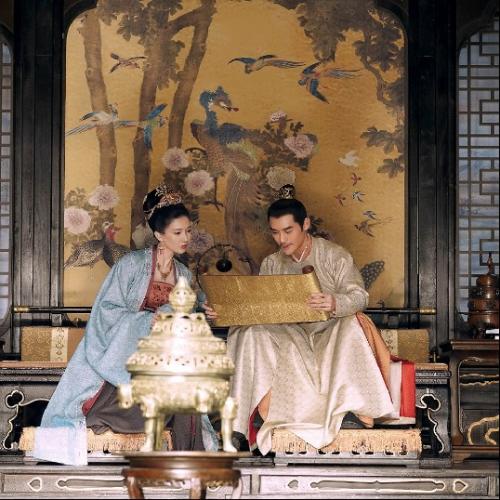



Serenade of Peaceful Joy (Qing Ping Yue), a historical TV drama about the life of an emperor of the Song Dynasty (960-1279), has become an unexpected hit among viewers of the Chinese mainland.
Unlike the Qing Dynasty (1664-1901), which is more familiar due to its proximity to modern times and has often been used as a backdrop for beloved historical dramas, the Song Dynasty (960-1279), often dubbed the Chinese Renaissance, has somehow become lesser known by today's Chinese viewers, especially younger generations.
But the show, released on April 7, has racked up more than 3.26 billion views online as of Monday, reported Maoyan, a major Chinese TV and film database.
The costume drama -- which stars the popular and seasoned actor Wang Kai, and perfectly blends romance and politics -- has drawn much attention from viewers for its depiction of refined Song culture, local media say.
Chronicling the four-decade reign of the fourth Song Emperor Renzong (1022-1063), the drama offers a glimpse into the arts, culture and social life of his time in a compelling portrayal that has sparked millions of posts and comments on social media.
Now let's take a close look at Serenade of Peaceful Joy and savor the brilliance of the culture and arts that radiate throughout the drama.

Song ceramics
Many viewers have marveled at the beautiful and elegant porcelain featured in the show. The Song Dynasty saw a great leap in both ceramic art and technology. History holds that there were more than 1,000 kilns around the country. Craftsmen competed with one another to advance kiln technologies as well as search far and wide for fine and new types of clay as well as exotic glaze colors.

Among all the kilns, five –Ru ware, Jun ware, Guan ware, Ding ware, and Ge ware – stood out for producing the best porcelain for royals to use. Influenced by the aesthetic prevailing among scholar-officials who valued minimalism and nature, Song ceramics are known for their straightforward shapes, muted coloration, glazes in subtle hues, and nature-inspired decorative motifs.
Distinct for its rare light bluish-green glaze, fine craftsmanship and jade-like gloss, Ru ware celadon is heavily featured in the drama along with a smattering of the black-glazed porcelain from the Ding ware.


Song Ci
The lyric poetry Ci, which enjoys the same renown as another artistic expression form Shi, originated in the late Tang Dynasty (618-907), but flowered and reached its zenith in the Song Dynasty.
Each piece of Ci is based on one of some 800 Ci Pai, originally titles of tunes, which specify the particular fixed pattern of tone, rhythm, number of characters per line and number of lines. Hence, it is common to come across several Ci penned by different poets about different topics sharing the same title.
Qing Ping Yue, the drama's title in Chinese, is a common Ci Pai used in Song poetry. Accomplished Song poets who were also important officials -- such as Yan Shu, Fan Zhongyan and Ouyang Xiu -- were featured in the drama, with several scenes dedicated to portraying them reading their own pieces.

Song painting
When it comes to masterpieces in ancient Chinese painting, no connoisseurs would avoid mentioning Along the River During the Qingming Festival (Qingming Shanghe Tu) or A Panorama of Rivers and Mountains (Qian Li Jiang Shan Tu).
Both were created during the Song Dynasty, an era in which, as many scholars believe, Chinese painting reached its pinnacle, with Huizong (1082-1135), the eighth Song emperor, an accomplished painter himself and also a patron of the arts.

With the prevalent aesthetic in that period emphasizing being true to the physical world, landscape and portrait paintings all come across as highly descriptive and even realistic.
In the drama, landscape paintings and portraits of auspicious animals are placed on walls or used as screens, giving an artistic and animated air to the palace's décor.


Song calligraphy
Along with poetry, calligraphy in Chinese culture is an important means for personal and creative expression. Overshadowing painting, it is also hailed as the supreme visual art form in Chinese culture.
By absorbing merits of legendary calligraphers from earlier times, famed Song calligraphers including Su Shi (1037-1101), Huang Tingjian (1045-1105), Mi Fu (1051-1107) and also Emperor Huizong, invented their own styles, widely imitated by calligraphy buffs even today.
In the drama, Emperor Renzong is keen on practicing calligraphy and excels at the lesser-known but rather characteristic calligraphy style called Fei Bai Shu, aka Flying White, which requires a flat painting brush. As its name suggests, this style places an emphasis on the moving force of the brush and the abundance of the streaks of white within strokes.


Flower arrangement
Flowers delicately arranged in porcelain vases in the drama are also a huge delight for the eyes.
Traditional Chinese flower arrangement originated from the Northern and Southern dynasties (420-589) and bloomed in the Tang and Song dynasties (607-1279).
Aside from serving the purposes of palace rituals and worship in temple, floral arrangement was revered by Song literati as one of "the four arts of life" along with incense burning, tea drinking and painting appreciation, which they used to express emotions, cultivate character and amuse themselves.


Incense burning
Unlike modern people who spray perfume to scent the air and body, ancient Chinese people were fond of burning incense made of fragrant wood and herbs, for an aesthetically pleasing atmosphere and naturally perfumed bodies.
That's why scenes with incense smoke curling upwards from animal-shaped copper burners or porcelain ones are pervasive in the drama.
Dating from the Shang Dynasty (c. 17th-11th BC), incense burning was initially and also essentially a part of worshipping practices to show respect to gods and ancestors.
In addition, ancient Chinese also burnt incense to tell time, repel insects and promote health with medicinal aromatic blends. Furthermore, literati in the Tang and Song dynasties held incense appreciation gatherings where they might also sip tea, listen to zither tunes, compose poetry and discuss painting.


Innovative tea drinking (dian cha)
Chinese culture has been steeped in tea drinking ever since the legendary Shennong (god of agriculture) serendipitously discovered this drink some five millennia ago.
Built on the rapid progress in tea plantation, tea processing and tea culture studies in previous dynasties, the Song eras saw a huge breakthrough in the way of tea drinking.

Unlike the Tang people who cooked tea with spices and ate the tea leaves afterwards, Song people revolutionized the practice with a new tea drinking method called dian cha, which was enjoyed as a recreation by people from all walks of life, as evidenced by a large number of tea houses depicted in the famed painting Along the River During the Qingming Festival (Qingming Shanghe Tu), which reenacted the bustling street scenes of the Northern Song (960-1127) capital Dongjing, today's Kaifeng in Henan province.
Dian cha, which inspired Japan's matcha tea ceremony, involves whipping the mixture of water and ground tea powder with a bamboo brush in a bowl to create a fine frothy drink. Tea connoisseurs were often drawn to tea-whisking contests where the winner was the one whose froth lasted the longest.
If you have any problems with this article, please contact us at app@chinadaily.com.cn and we'll immediately get back to you.